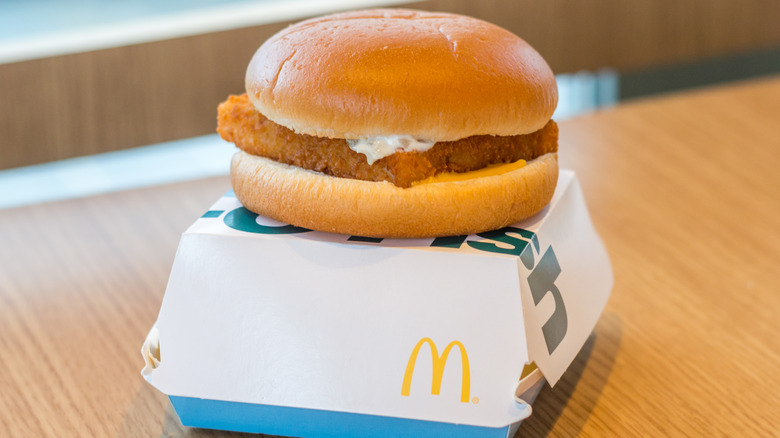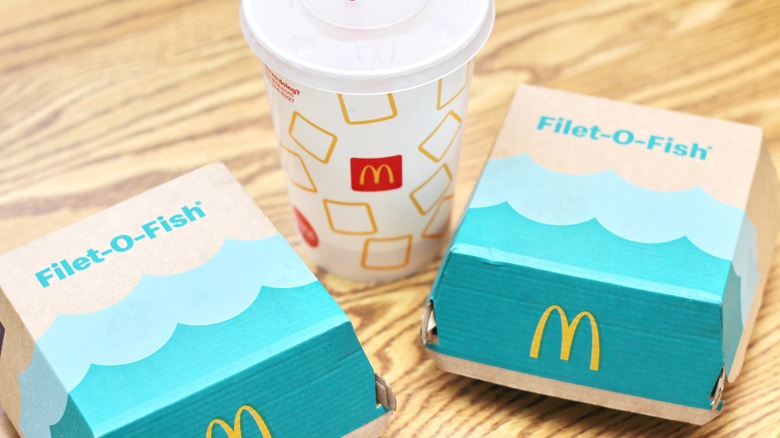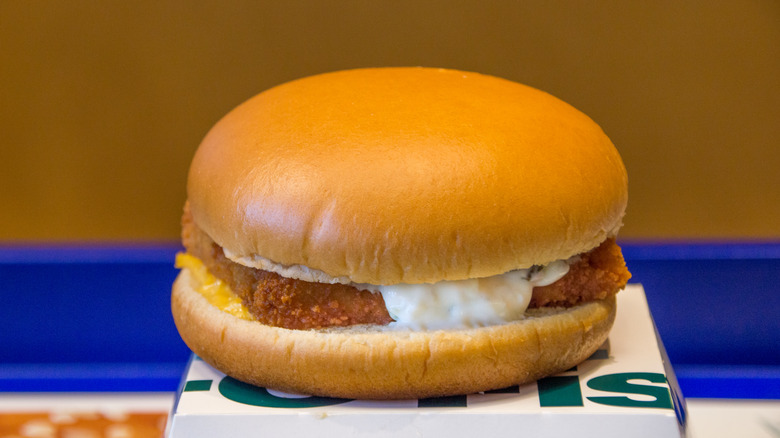The McDonald's Filet-O-Fish Almost Didn't Exist Because Of The Smell
It's no "sea-cret" that McDonald's isn't known for being the most "so-fish-ticated" joint. Fish puns aside, it's likely that if you were a "Family Feud" contestant and asked to "Name something you'd find at a McDonald's," you might shout out responses like "hamburger," "chicken nuggets," "french fries," or "McFlurry." If "fish" came to mind, then you may be one of the customers who has helped McDonald's sell at least 300 million Filet-O-Fish sandwiches each year, the majority of which, 23 percent, are sold during Lent. Whether you're a fish fanatic or just enjoy the cod and cheese-based sandwich, you may be unaware that at one time, if you were looking for fish at Mickey D's, you would have had to drop a line at a different chain.
Although the first McDonald's opened in 1955, the Filet-O-Fish sandwich made its debut on the menu one decade later. Roman Catholics in Cincinnati are often credited with influencing the sandwich's inception. Lou Groen, a McDonald's franchise owner from Cincinnati, suggested that fish should appear on McDonald's menu after noticing that his business was hurting on Fridays when Roman Catholics couldn't eat meat. In an interview with the Chicago Tribune, Groen said, "I was struggling ... [because] that area was 87 percent Catholic. On Fridays, we only took in about $75 a day." Despite Groen's fish proposal, Ray Kroc, McDonald's CEO at the time, was against the idea. A sandwich competition between the men helped determine the Filet-O-Fish's fate.
What was the Filet-O-Fish's fate?
Before he had fish on his mind, Lou Groen was starting his first Cincinnati McDonald's franchise in 1959. Before the Second Vatican Council's decision in the early 1960s, Roman Catholics had to ditch meat on Fridays. Because Groen's business was in a Catholic neighborhood, he created a model for a fish sandwich in 1961. However, in Ray Kroc's memoir, "Grinding It Out: The Making of McDonald's," he wrote that Groen's desire to introduce the Filet-O-Fish was "born of desperation" (via Insider). Kroc initially despised the Filet-O-Fish idea. He writes that his first response was, "Hell, no! I don't care if the Pope himself comes to Cincinnati. He can eat hamburgers like everybody else. We are not going to stink up our restaurants with any of your damned fish."
After Groen and executives Fred Turner and Nick Karos contested Kroc's objection, the Filet-O-Fish still had a fighting chance. Groen said that it was either selling fish sandwiches or his franchise. After Kroc caved, Al Bernardin, a businessman who also invented the Quarter Pounder, worked on developing the Filet-O-Fish sandwich. Although the team used cod, Kroc said that the name "brought back too many childhood memories of cod liver oil." He requested that they rebrand "cod" as "North Atlantic whitefish." One of Groen's younger employees suggested adding cheese to the sandwich, which Kroc said he thought was "delicious." But the Filet-O-Fish didn't prove itself worthy just yet.
A contest to determine whether the Filet-O-Fish would sink or swim
After much concern about the Filet-O-Fish "stinking up" McDonald's," Ray Kroc proposed that the sandwich would battle his creation, the "Hula Burger." The "burger" was just a toasted sandwich with two pieces of cheese and grilled pineapple. In 1962, on Good Friday, the battle began. Three hundred and fifty customers purchased Lou Groen's fish sandwich, while just six customers ordered the Hula Burger. In his memoir, Kroc wrote that Groen frequently joked with him about the Hula Burger's fate, but Kroc added that he still enjoyed his "delicious" creation at his house.
After the Filet-O-Fish debuted temporarily in 1963, it was officially added to U.S. menus in 1965 with the catchphrase "the fish that catches people." Although Kroc may have been "jelly" of Groen's win, it largely benefited Groen. The item not only brought him a lot of money at his first McDonald's franchise, but he went on to open 43 McDonald's in Cincinnati, eventually had 3,000 employees, and had yearly sales of $60 million. Ironically, Kroc correctly predicted that the Pope would eventually change his rules regarding eating meat. He wrote that he told Catholic colleagues, "You fellows just watch. Now that we've invested in all this equipment to handle fish, the Pope will change the rules." In 1965, the Roman Catholic Church began allowing Catholics to eat meat on Fridays — just not during Lent. However, without its initial rules, the Filet-O-Fish may have never been born.


